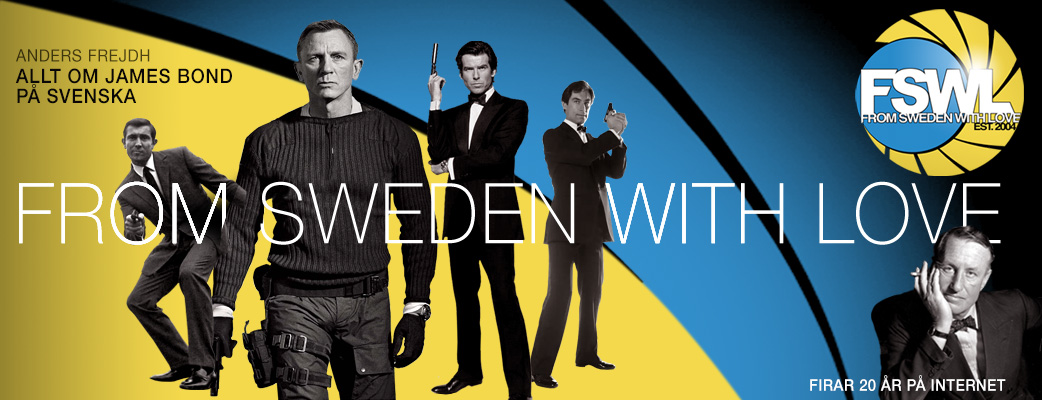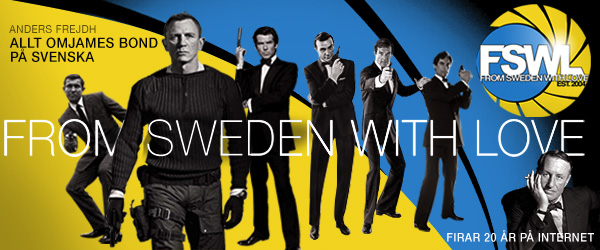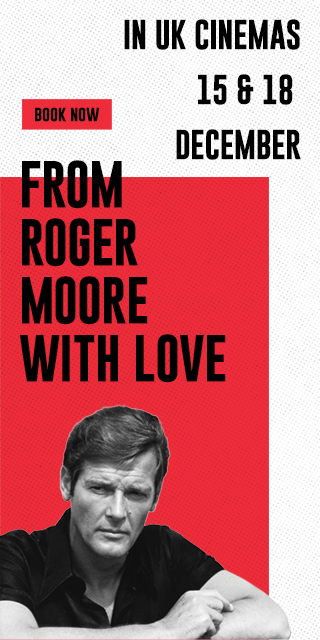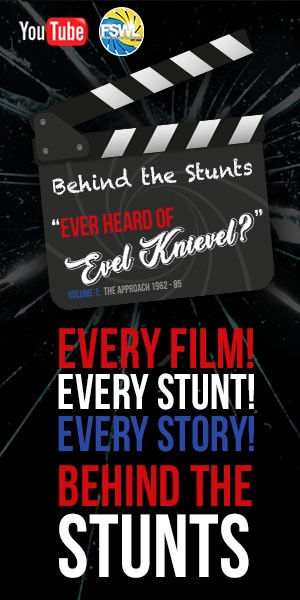Hemsidan senast uppdaterad: 2025-06-10
Hem
Bok- och filmrecensioner
Event
FSWL Merchandise
Intervjuer
James Bond 007 filmerna
James Bond 007 litteratur
James Bond 007 nyheter
James Bond 007 produkter
James Bond 007 samling
James Bond 007 shop
James Bond 007 spel
James Bond fanklubbar
James Bond personligheter
Svenskar i Bond-filmerna
Tävlingar
Till minne av
A Celebration of Sir Ken Adam - Gun Metal Genius
Av: Ajay Chowdhury
Publicerad:
2016-10-30
2016-10-30

Order of events, Ken Adam – A Celebration, NFT 1, National Film Theatre, London 1st June 2016
Hosted by long-time friend and Ken Adam biographer and historian, Sir Christopher Frayling, the audience was taken through personal anecdotes about the designer by an interesting assortment of speakers.
First was Gieron Sierverich, Director of the the German museum which housed Sir Ken’s millennium installation in Berlin. Then was Squadron Leader Jeff Metcalfe represented Sir Ken’s association with the Royal Air Force squadron with whom the German native flew, with his brother, during World War II as an un-naturalised British citizen. Other speakers came from various aspects of the film business including producer Sandy Lieberson and architect Sir Norman Foster on whose angular steel and glass designs Sir Ken’s influence can be boldly seen. Sir Ken won his first Oscar for Stanley Kubrick’s Barry Lyndon (1975), their second collaboration after their memorable on nuclear satire, Dr Strangelove (1963) where the design made a fictitious underground bunker like a poker players’ table. The director’s daughter, Katharina Kubrick, was there to share her memories of when Sir Ken sought Kubrick’s help to light the interior of the Liparus supertanker from The Spy Who Loved Me (1977). Katharina, incidentally, helped design Jaws’ steel teeth. Sir Ken’s second Oscar came from the similarly atypical, period piece, The Madness Of King George (1994) and the director, Sir Nicholas Hytner and writer of the film, Alan Bennett, were on hand to give their recollections of an unlikely partnership, citing Sir Ken’s artistic integrity and resourcefulness on a production with the usual Ken Adam-ian budget.
Of course, it was Sir Ken’s association with the Bond films which is what most cinema audiences remember him for. Ken Adam worked on Dr. No (1962), Goldfinger (1964), Thunderball (1965), You Only Live Twice (1967), Diamonds Are Forever (1971), The Spy Who Loved Me (1977) and Moonraker (1979) and concept work for the computer game, GoldenEye – Rogue Agent (2004). To represent 007, Bond co-producer Michael G. Wilson and Sir Ken’s heir to the Bond design throne, Peter Lamont shared fine memories of the man. Sir Roger Moore put it eloquently in his speech where he referred to the actor playing Bond being merely a jewel placed in the finely wrought setting designed by Sir Ken.
Interweaved in the speeches were film clips and film of Sir Ken in an impressionistic recreation of his work room in his Montpelier Street home together with blinds and Anglepoise lamp, which was filmed specially for an exhibition in Germany.
In deep appreciation of the tributes was Sir Ken’s widow, Lady Letizia Adam, there in person. Letizia and Sir Ken has strong ties to the Polish community in London and also in attendance was Lili Pohlman (with her daughter, Karen), partner of Ian Fleming’s agent Peter Janson-Smith, who also passed away this year in his nineties.
In addition to the aforementioned, in attendance to keep the Bond end up were numerous figures from the gun-metal days: five time Bond director John Glen, special effects supervisor John Richardson, associate producer William P Cartlidge, the first Bond Oscar winner, Norman Wanstall, Steven Saltzman and Sue St John (Harry’s son and PA respectively). From the more recent 007 past were writers Neal Purvis and Robert Wade, executive and associate producers Callum McDougall and Gregg Wilson, composer David Arnold and Bond girls/film-makers Carole Ashby and Maryam D’Abo (with her spouse, Chariots Of Fire director Hugh Hudson). Barbara Broccoli brought some of her crew from the new non-Bond Eon Production, Film Stars Don’t Die In Liverpool, due in 2017.

The Judgment of Posterity featuring Top L-R: Katharina and Christiane Kubrick (daughter and widow of Stanley Kubrick), Julia Peyton-Jones, Alice Rawsthorne, Jan Harlan (brother of Christiane) Middle L-R Peter Lamont, Barbara Broccoli, Eunice Gayson, Caroline Munro, Lewis Gilbert, Sir Christopher Frayling, Sir Ken and Lady Letizia Adam, Bottom L-R Martine Beswick, Lana Wood, Nicholas Meyer, Shirley Eaton, Michael G. Wilson, A BAFTA Tribute to Sir Ken Adam, Royal Institute of British Architects, London, April 2011
***
Over the years, Sir Ken’s work had been celebrated at various exhibitions including a term at the Serpentine Gallery in London’s Hyde Park in 1999 and subsequently in exhibitions in his native Germany. The designer had spoken fondly of his work at a number of events including at a talk in London in 1999, a celebration of the centenary of Albert R. Broccoli at the same venue in 2009 and then a British Academy Of Film and Television Arts (BAFTA) presentation in 2011.

Sir Christopher Frayling (left) interviews Sir Ken Adam, behind a slide of the 63 foot model of the Liparus supertanker in its Bahamian berth, Cubby Broccoli: 'From The Red Beret To Bond' Centenary Celebration at the BFI, National Film Theatre, London, May 2009
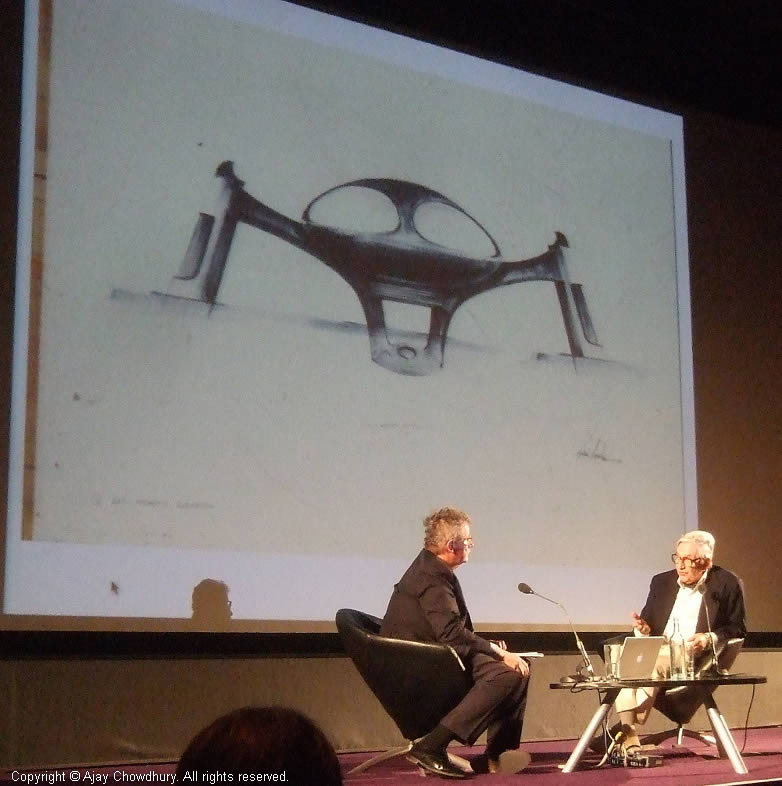
Sir Christopher Frayling (left) interviews Sir Ken Adam, behind a slide of Atlantis, Cubby Broccoli: 'From The Red Beret To Bond' Centenary Celebration at the BFI, National Film Theatre, London, May 2009
The work of a production designer on a movie is more than just designing and overseeing the construction of sets. A designer is often involved at the inception of a project as it is their work that will shape the schedule and budget of a production. Sets inform the audience about character and how the frame is composed in all three dimensions. Sets must allow for both the movement of actors through the space as well the movement of the crew and the rigging of lighting. Where real locations are used, the set must sometimes be dressed and altered. A designer must look at how costumes and props relate to the set in terms of colour and form. The designer is in charge of the total physical appearance of the production. Adam was a protégé of the first production designer in films, William Cameron Menzies, for whom the term was coined on Gone With The Wind (1939). Adam was also inspired by the German Expressionism movement of the 1930s: images which were stark, atmospheric, noir-esque and surreal.
From his work on Dr No, the first film to show the electronic age in a tongue-in-cheek manner. His wife, Letizia, suggested he could not do Dr No as it would be "prostituting [his] art". But Adam was comfortable with the personnel behind the first James Bond film: he had worked in the sphere of Albert R. Broccoli on The Trials Of Oscar Wilde (1960), In The Nick (1961) and The Long Ships (1964 - released under the Warwick banner by Irving Allen on his own). Adam had known and liked both Terence Young and Sean Connery. At first Adam balked at doing the movie whose design budget was 14,000 GBP but relented when told there was a contingency amount of 7,000 GBP. Which was just as well. Whilst the Spider Room set, where Dent collects the tarantula later to be placed in Bond's bed, was the first glimpse of Dr No's world, it was one of the last sets to be built. Adam had to scrape up the money to build it. Terence Young loved the finished product and suggested changes so that the set could be used more effectively. Needless to say, when the crew received a visit from the completion guarantee company towards the end of the shoot, Broccoli advised Adam to hide! Adam was generally left to his own devices as everyone was away on location whilst building took place. The designer wanted to get rid of the old construction methods and use new ideas and materials such as plastics and different types of metal treatments. Adam was assisted by Ronnie Udell and the construction heads at Pinewood Studios who were "very supportive". However, his vision was sometimes grounded by the budget and the need for haste. It was Adam himself who painted the Goya portrait of Wellington, over a weekend for use on Monday morning, from a transparency hurriedly obtained from the National Gallery the previous Friday afternoon.
On Goldfinger, there had been discussion about whether Bond should drive a Bentley as he did in the Ian Fleming novels. Aston Martin was decided upon but Adam could not persuade David Brown, the then Chairman of Aston Martin and the DB in DB5, to say yes. Adam recruited Broccoli and Harry Saltzman who persuaded Brown that use of the car in the film would promote sales - an understatement for what would go on to become the most famous car in the world. The car's gadgets were the result of a revenge fantasy/dream of Adam's. In the 1960s, Adam owned an E-Type Jaguar, which was always getting damaged. The defence mechanisms on the DB5 were the car "getting its own back". Adam in the past had paid tribute to the man who realised his vision: John Stears, special effects superviser on the early Bonds and Oscar-winner for Thunderball and Star Wars – A New Hope (1977); and Eon's Mr Fixit, the legendary Colonel Russhon who was responsible for obtaining the ejector seat.
The early days of Eon were like a "debating society - nobody had ego problems". Adam had paid tribute to Ferdi Gallau who was responsible for the tapestry in Thunderball and Jill Noise, recruited from the opera, to work on The Spy Who Loved Me. Indeed it was this pioneering spirit of creative co-operation and long-term vision, rare in the entertainment industry, that allowed Ken Adam to embark upon the most ambitious set ever conceived for the cinema - Blofeld's crater hideaway for You Only Live Twice.
By this time, James Bond films were so important and popular that the release date had been decided on despite the lack of a script. Adam had recalled the You Only Live Twice script conferences were sluggish and that the original American writer was fired. Sean Connery's Bond film contract was running out. Adam showed his sketch of an initial design to Cubby who, after Adam paused at the producer's initial question of "How much?", asked, "Will one million dollars cover it?" The enormous pressure of building the set was not leavened by the numerous variables and unknown factors involved. The Polish helicopter pilot who flew into the full size crater was uncertain how updrafts and downdrafts would operate in the unique structure. Adam had always praised the building team headed by "the best construction manager in the world, Ronnie Udell." Sad at having to strike the crater set because, built as an exterior, it was an eyesore and could not stay up, Adam learned a useful lesson which he would remember later on in his Bond career.
Because a designer is involved at the start of a production, some of the sketches captured early, eventually un-used ideas. An initial concept for You Only Live Twice was an "Oriental Gambling Casino", a distinctly colonial affair. Initially the poisonous cavern at the base of the volcano included the gruesome detail of an Ama girl hanging from gallows.
Whilst Adam did not work on the final production of On Her Majesty’s Secret Service, in the recent biography of the 007 films, Some Kind Of Hero, Sir Ken revealed that he had scouted locations for the picture when it was due to be made in the mid-Sixties and had come up with a unique concept for Draco’s HQ.
Diamonds Are Forever was to have been shot at Universal Studios but was eventually made back at Pinewood Studios. Initial sketches for the villains base had "HH" visibly removed - a slip revealing the source of their inspiration, Cubby Broccoli's reclusive friend, Howard Hughes. Earlier sketches of the same design feature the letters "GG", perhaps relating to the early development of the screenplay when the villain was going to be Goldfinger's twin brother.
For The Spy Who Loved Me, Ken Adam built the 007 Stage, the world's largest soundstage, around the Jonah-esque Liparus supertanker set so that at the end of the production, the facility could be re-used. Adam also experimented with elliptic shapes for Stromberg’s HQ Atlantis. This work was further developed in the aspirationally accurate space designs from Moonraker. The film also featured a concept for an Eiffel Tower restaurant - a tantalising allusion to a sequence subsequently filmed for A View to a Kill (designed by Adam's protégé, Peter Lamont some 6 years later).
Adam had stopped doing Bonds for a variety of reasons. He has said he was exhausted after doing Moonraker but also budgetary disciplines and different creative pastures led him down a different path.
Adam worked on other projects such as The Ipcress File (1965) ("Harry Saltzman always thought we were going to make a cheap Bond") and Cubby Broccoli’s adaptation of Ian Fleming’s children’s adventure, Chitty Chitty Bang Bang (1968). The windmill used in the film by Caracatas Potts was owned by the aforementioned David Brown of Aston Martin. Adam designed the airship used by the Gert Fröbe's Baron and the model was built by Malcom Smith for 7,000 GBP. It was about 140 foot long and filled with helium. However, shooting coincided with terrible gales and the model broke loose and hit power lines, cutting off the electricity in Hampshire.
Adam had had a long association with the late Stanley Kubrick, who, impressed after seeing Dr No, summoned the designer to the Westferry Hotel to discuss Dr Strangelove. Adam always felt "you had to intellectualize your lines to [Kubrick]": hence the designer's rationalization of the War Room as really a grand setting for a poker game! Adam was frustrated with Kubrick's insecurity throughout the shooting of Barry Lyndon.
Ken Adam also was involved in various other projects including designs for opera sets, a multi-media centre for 20th Century Fox and a mobile display for celebrating the new millennium in Berlin. He had also worked on Star Trek in 1977 when the project was being developed by Gene Roddenberry at Paramount with Philip Kaufman directing.
Lack of resources of smaller fayre did not force Adam to compromise. In India in 1988, shooting the Merchant-Ivory production, The Deceivers the designer travelled by car around the country with actor Saeed Jaffrey and his wife, Jennifer, looking for authentic sites. The period historical adventure starred Pierce Brosnan and the director shared his designer’s unwavering artistic integrity to an amused audience in 2011.
Sir Ken Adam's production design has undeniably defined the look of the Bond films and established a gold standard for film set design. His work has formed the superstructure to cinematic dreams worldwide, for generations in the past and for generations yet to come.
Written by Ajay Chowdhury. Copyright © 2016 From Sweden with Love
Taggar:
#ajay_chowdhury
#artiklar
#ken_adam
Tweet
